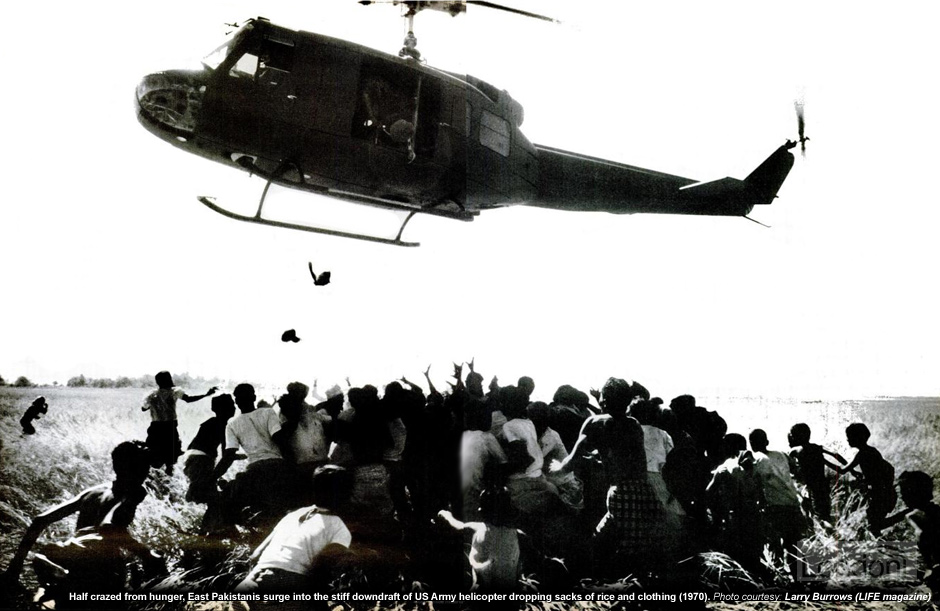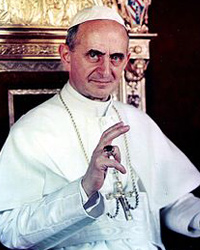
International response
As news of this disaster reached the outside world, relief began to arrive from both nearby and distant countries. The cyclone roused the sympathy of other countries for the plight of East Pakistanis and highlighted the latter's standing grievances against the West Pakistanis. About 70 countries, numerous voluntary agencies, and the United Nations (U.N.) took part in the relief effort. The Government of East Pakistan decided what supplies were needed and where they were needed, and it supplied most of the medical and support personnel in the cyclone area. Donor countries and voluntary agencies contributed blankets, tents, food, and, most important in the initial relief phase, helicopters. Ferrying in supplies to remote locations by air and rescuing those needing medical attention helped save many, but the scale of the disaster was too big to reach all who were in need. Starvation, exposure, and disease kept adding to the death toll.
| Country/organisation | Donation (million dollars) |
|---|---|
| USA | 39 |
| Great Britain | 5.4 |
| UN (United Nations) | 4.9 |
| European Common Market | 2.3 |
| Canada | 2.2 |
| Japan | 2.1 |
| West Germany | 1.6 |
| India | 1.3 |
| China | 1.2 |
| Caritas, Internationalis | 0.9 |
| Netherlands | 0.8 |
| USSR (Soviet/Russia) | 0.7 |
| Australia | 0.6 |
| Sweden | 0.6 |
| Saudia Arabia | 0.5 |
Source: US Government Accountability Office
The reaction of Western aid agencies is often to recommend introducing methods that would be considered desirable in, say, the United States or Europe. For developing countries that have very little financial resources to do more than the minimum amount of defense against the next cyclone, much simpler and quicker approaches are needed.
India first country to pledge relief - even before Pakistani government
The first material aid given to this region came not from Pakistan, but rather Pakistan's supposed enemy India, which immediately provided cash for disaster relief and pledged £0.8 million (1970, £5 million 2007) by end of November.
However, the Pakistani government refused to allow the Indians to send supplies into East Pakistan by air, forcing them to be transported slowly by road instead. The Indian government also said that the Pakistanis refused an offer of military aircraft, helicopters and boats from West Bengal to assist in the relief operation.
The government took three days to decide to ask for US helicopters and then haggled over who would fly them. British amphibians arrived but were left parked in a warehouse, and West German medical help was refused because the government couldn't feed and house doctors and nurses. Unwilling to rise above traditional hatreds, India balked at allowing rescue flights to land and refuel, and Pakistan hesitated to lose face by begging an old enemy for mercy. Meanwhile, despair spread. "If the government and international agencies do not help us," said a villager, "we shall all have to die".
American help
US President Richard Nixon allocated a $10 million (1970 USD, $53 million 2007 USD) grant to provide food and other essential relief to the survivors of the storm, and the U.S. ambassador to Pakistan pledged that he would "assist the East Pakistan government in every way feasible". The American government also sent a number of blankets, tents and other supplies. Six helicopters, two helicopters at an aid mission in Nepal and four from the United States, were sent to East Pakistan. Some 200,000 tons of wheat were shipped from the United States to the stricken region.
CARE (Cooperative for Assistance and Relief Everywhere), a non-governmental organisation fighting global poverty, halted aid shipments to the country the week after the cyclone hit, because of unwillingness to let the Pakistani government handle distribution. However, by January, they had reached an agreement to construct 24,000 cement brick houses at a cost of about £0.8 million (1971, £5 million 2007). American concerns about delays by the Pakistani government in determining how the relief should be used meant that $7.5 million (1970 USD, $39.7 million 2007 USD) of relief granted by the US Congress had not been handed over in March. Much of the money was earmarked to be spent on constructing cyclone shelters and rebuilding housing. The American Peace Corps offered to send volunteers but were rebuffed by the Pakistani government.
British help
Great Britain pledged $7.2 million for reconstruction efforts. A Royal Navy task force, centred on HMS Intrepid and HMS Triumph, left Singapore for the Bay of Bengal to assist with the relief efforts. They carried eight helicopters and eight landing craft, as well as rescue teams and supplies. The British assault craft were the first means of transport capable of reaching some of the worst-hit islands. Fifty soldiers and two helicopters were flown in on 20 November 1970 from their bases in Singapore ahead of the ships to survey the disaster area and bring relief work.
The troops brought vehicles with them to help in the massive job of reconnoitring [making military observation] the disaster area for the most effective means of bulk distribution of relief supplies when it arrives by sea from Singapore on 24 November 1970.
The British task force arrived off the Pakistan coast on 24 November 1970, and the 650 troops aboard the ships immediately began using landing craft to deliver supplies to offshore islands. By the end of November, there were 38 helicopters operating in the disaster area, 10 of which were British and 10 American. The British had provided about 70 small boats and the Americans 50 for supply distribution.
West Pakistan has a bumper wheat crop, but the first shipment of food grain to reach us is from abroad. The textile merchants have not given a yard of cloth for our shrouds.
We have a large army but it is left to the British Marines to bury our dead.
Singapore Government help
On 20 November 1970, the Government of Singapore announced its offer to send a 'self-contained and self-supporting' military medical mission to East Pakistan. The following day an advance party led by Major (Dr) Roy Paul and Major Henry Teo left for Dhaka to study the latest situation in the cyclone affected area.
On 1 December 1970, a 45-member strong Singapore Armed Forces Medical Mission, led by Captain (Dr) Seet Lip Chai as Commanding Officer, arrived at Patenga Airfield near Chittagong by RAF Hercules Aircraft. On arrival, they were warmly welcomed by Pakistan military and civil authorities and quickly established their base camp at the Airstrip. They set up wireless communications for direct communication between the mission base headquarters and MINDEF (Ministry of Defence, Singapore). The relief team encountered difficulties in the cyclone ravaged islands as it was impossible to utilise motorised transport, thus they were forced to use bicycles, boats and helicopters as their main means of transport.
The mission was split into four teams and deployed to the island of Sandwip, 35 miles west of Chittagong and started vaccinating the inhabitants against smallpox. A medical care clinic was also opened at Sandwip on 4 Dec 1970. The medical teams moved from house to house and by 6 Dec 1970, they had vaccinated 3,700 people. During their three weeks there, the medical mission treated 26,786 people, including preventive and curative cases.
Medical supplies worth about $50,000 were handed over to the local medical authorities, while 15 tons of canned food were forwarded to local relief centres for distribution to the victims. The medical mission returned to Singapore on 22 Dec 1970. To have undertaken such a mission just 5 years after its formation spoke well of the professionalism and organisational ability of the SAF Medical Corps.
That Singapore offered such assistance at a time when it was itself not yet economically stable indicated the level of concerned international citizenship that we aspire to.
East Pakistan - the first ever recipient of International Development Association's reconstruction credit
On 12 January 1971 the International Development Association (IDA) - the World Bank's fund for the poorest - approved a credit of US $25 million for Cyclone Protection and Coastal Area Rehabilitation Project to assist in rebuilding the economy of East Pakistan devastated by the cyclone and in providing the population of the region with some protection facilities. This was the first reconstruction credit for IDA.
Other international help
Pope Paul VI interrupted his journey to Manila, Philippines, where he was to preside over the Asian Bishop Conference and flew into Dhaka in the early morning (1.15 am) of 27 November 1970 for a one-hour visit after stopping over briefly in Teheran, Iran. The Pope was greeted at the airport by President Yahya Khan. East Pakistan Governor, Vice-Admiral Syed Mohammad Ahsan, and Central Ministers and high ranking civil and military officials were high ranking civil and military officials were also at the Airport to receive the Pope.
 Paul VI (aka Giovanni Battista Enrico Antonio Maria Montini) (1897 – 1978)
Paul VI (aka Giovanni Battista Enrico Antonio Maria Montini) (1897 – 1978)
In what was the first visit by a pope to a Muslim country, the 73-year-old urged people to pray for the victims of the disaster.
I come among you as a friend and brother. I want you to know that I share your suffering, and I offer my deep sympathy to the families who have been affected by this tragedy.
Pope Paul VI appeals to the people of the Bhola Cyclone devastated areas not to despair
The Vatican later contributed $100,000 to the relief efforts.
By the start of 1971, four Soviet helicopters were still operating in the region transporting essential supplies to hard-hit areas. The Soviet aircraft, which had drawn criticism from Bengalis, replaced the British and American helicopters that had operated immediately after the cyclone.
The Japanese cabinet approved a total of $1.65 million of relief funds in December. The Japanese government had previously drawn criticism for only donating a small amount to relief work. The first shipment of Chinese supplies to East Pakistan was a planeload of 500,000 doses of cholera vaccine, which was not necessary as the country had adequate stocks. The Chinese government sent $1.2 million in rice, blankets, and medicine. Mohammad Reza Pahlavi declared that the disaster was also an Iranian one and responded by sending two planeloads of supplies within a few days of the cyclone striking. A Kuwait Airways Trident, with its interior converted for cargo handling, also brought in supplies. A Swiss Charter aircraft was among the first of the international rescue fleet to arrive in Dhaka. Many smaller, poorer Asian nations sent nominal amounts of aid.
UNICEF helped to re-establish water supplies in the wake of the storm, repairing over 11,000 wells in the months following the storm. UN Secretary-General U Thant made appeals for aid for the victims of the cyclone and the civil war in August, in two separate relief programs. He said only about $4 million had been contributed towards immediate needs, well short of the target of $29.2 million. By the end of November, the League of Red Cross Societies had collected $3.5 million to supply aid to the victims of the disaster
$185 million required to rebuild damaged areas
The World Bank estimated that it would cost $185 million to reconstruct the area devastated by the storm. The bank drew up a comprehensive recovery plan for the Pakistani government. The plan included restoring housing, water supplies and infrastructure to their pre-storm state. It was designed to combine with a much larger ongoing flood-control and development program. By the start of December, nearly $40 million had been raised for the relief efforts by the governments of 41 countries, organisations and private groups.
